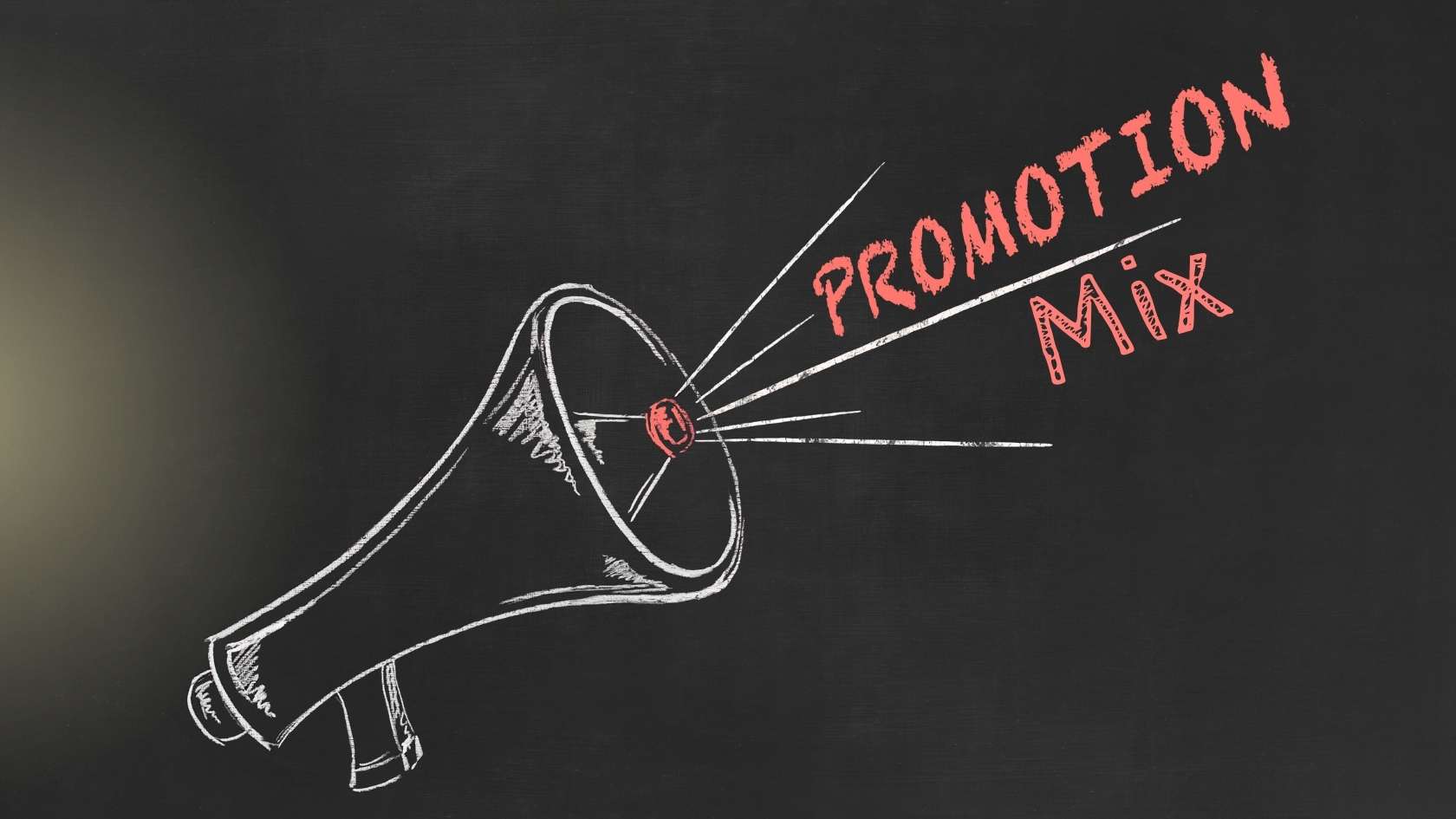What makes you remember a brand long after you’ve seen its ad? Is it the striking visuals, a catchy tagline, or the way it speaks directly to your needs? Successful brands don’t rely on luck; they use a strategic promotion mix to ensure their message reaches the right audience at the right time.
Table of Contents
So, what is promotion mix? It’s a combination of marketing techniques like advertising, public relations, personal selling, direct marketing, and digital marketing. When used effectively, these elements work together to create brand awareness, engage customers, and drive sales.
In today’s crowded market, standing out requires more than just a great product or service. Businesses must craft a promotion mix that strategically blends different marketing efforts to capture attention and build lasting relationships with customers. In this blog, we’ll explore the key elements of a promotion mix, why it matters, and how to use it effectively.
What is Promotion Mix?
Promotion mix refers to the combination of various marketing communication tools and strategies that a business uses to promote its products or services, connect with its target audience, and achieve its marketing goals. It typically includes methods such as advertising, sales promotions, public relations, personal selling, direct marketing, and digital marketing—each playing a role in achieving specific promotional objectives.
Each tool has its own purpose. For example, advertising helps reach a large audience, while personal selling is useful for building trust and relationships. Businesses choose the right mix based on their goals, target audience, and budget. A well-planned promotional mix helps increase brand awareness, attract customers, and boost sales. It’s a key part of any successful marketing plan.
Elements of a Promotional Mix
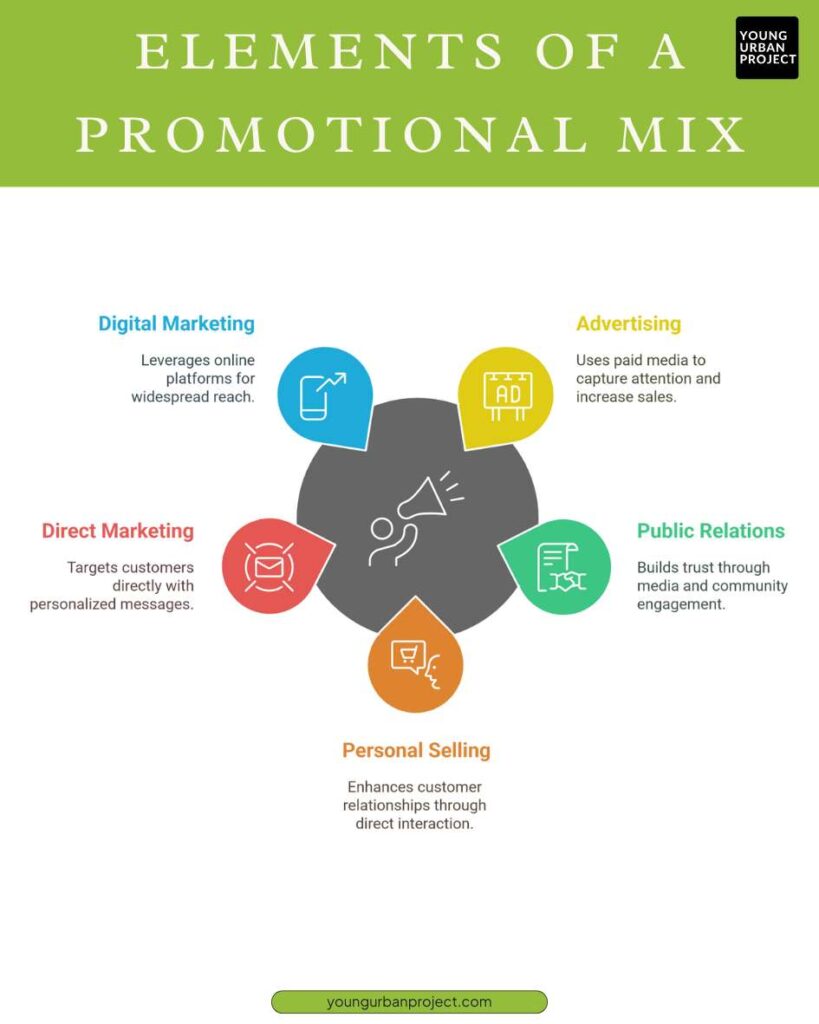
1. Advertising
When a company wants people to know about its product, advertising is the easiest way. It includes TV ads, online banners, billboards, and even social media posts. Businesses pay for these ads to grab attention and increase sales. A good ad is short, clear, and memorable. Companies often use catchy slogans or creative visuals to make sure customers remember them.
CheckOut: Advanced Facebook Ads Course
2. Public Relations (PR)
PR is all about how a brand presents itself to the public. Instead of paying for ads, businesses work with news outlets, influencers, or charities to create a positive image. When a company sponsors an event or appears in a news article, people trust it more. Good PR helps a business stay in the spotlight without direct advertising. It also helps manage any negative publicity.
3. Personal Selling
Ever walked into a store and had a salesperson help you choose a product? That’s personal selling. It happens face-to-face, over the phone, or through video calls. It works best for expensive products like cars or real estate, where customers have a lot of questions. The salesperson’s job is to explain, convince, and build trust. This method creates strong customer relationships and boosts sales.
4. Direct Marketing
Direct marketing is when companies reach out to customers directly, without any middlemen. Think of emails, text messages, brochures, or even phone calls. Businesses use this method to send special deals or updates. Since the message is targeted to specific people, it often leads to quick responses. Many companies use direct marketing for seasonal promotions, loyalty programs, or personalized discounts.
5. Digital Marketing
Since most people are online, digital marketing is one of the most powerful ways to promote a product. It includes social media ads, search engine marketing, email campaigns, and influencer promotions. Businesses use platforms like Facebook, Instagram, and Google to connect with their audience. Digital marketing is cost-effective, easy to track, and can reach people worldwide in just seconds.
Also Read: What is Marketing Mix Modeling (MMM)
Importance of Promotion Mix
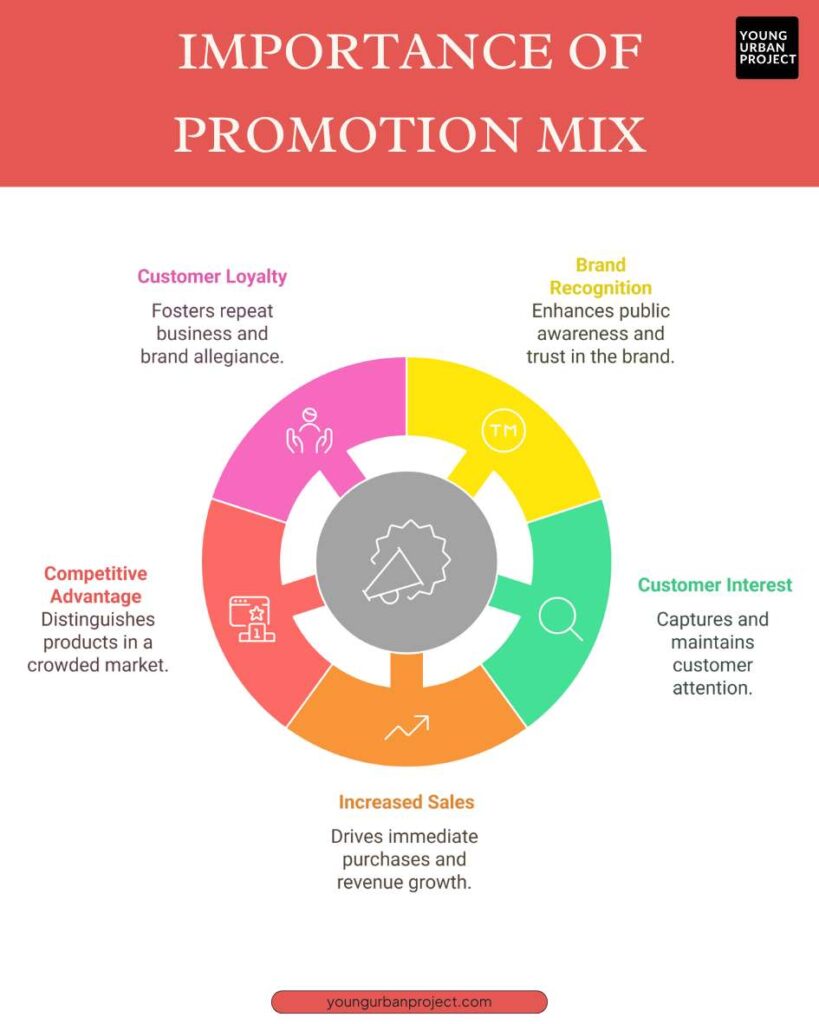
1. Builds Brand Recognition
If people don’t recognize a brand, they’re unlikely to buy from it. That’s where promotion comes in, it introduces businesses to the public through ads, PR, and social media. The more people see a brand, the more familiar and trustworthy it becomes. Over time, logos, slogans, and products start to stick in their minds. A strong promotional strategy keeps a business top of mind, increasing its chances of success.
2. Captures Customer Interest
With so many products competing for attention daily, businesses need to stand out fast. A well-planned promotional mix sparks curiosity through eye-catching ads, engaging social media campaigns, and compelling emails. Interactive content, like videos and polls, grabs attention and keeps potential buyers interested. Promotions also help customers understand why a product is worth their time, making their buying decision easier.
3. Boosts Sales and Revenue
Promotion drives sales by giving people a reason to buy now. Limited-time offers, discounts and persuasive messaging create urgency, pushing customers to act. Direct marketing and personal selling allow businesses to connect with buyers, address concerns, and offer solutions. The better a company promotes its products, the more revenue it brings in.
4. Sets Products Apart from Competitors
In a crowded market, businesses must show what makes them different. A strong promotional strategy highlights a product’s best features, value, or uniqueness. Effective marketing—through storytelling, testimonials, and influencer partnerships—can make one product seem like the obvious choice. When a brand positions itself well, it creates a lasting impression that sets it apart.
5. Encourages Customer Loyalty
Getting new customers is great, but keeping them is even better. Promotions help brands stay connected through loyalty programs, exclusive offers, and social media engagement. When customers feel valued, they’re more likely to come back. Regular promotions remind them why they chose a brand in the first place, strengthening trust and increasing repeat purchases.
Also Read: What Is Price Mix
How to Use a Promotional Mix
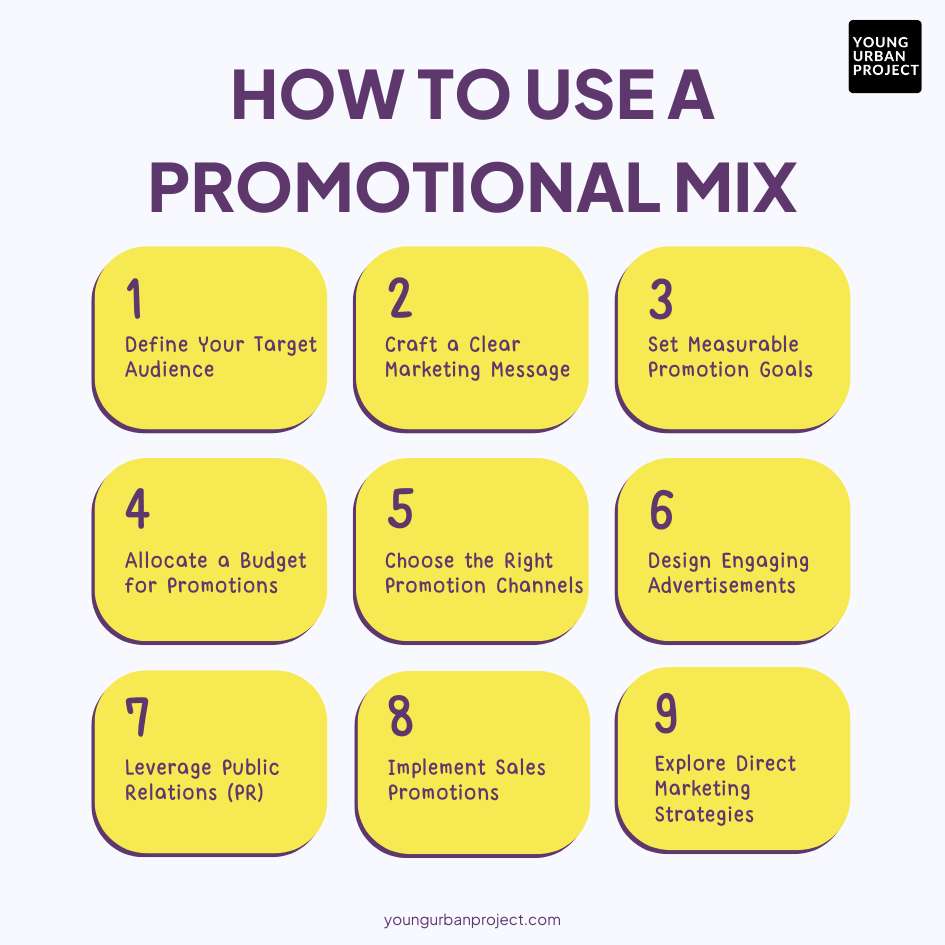
1. Define Your Target Audience
Before promoting your product or service, you need to know who your ideal customers are. Consider their age, gender, income level, interests, and shopping behavior. Think about what problems they face and how your product solves them. The better you understand your audience, the easier it is to create messages that appeal to them. When promotions match customer needs, they are more likely to respond positively and make a purchase.
2. Craft a Clear Marketing Message
A strong marketing message tells people why they should choose your brand. It should be simple, clear, and easy to remember. Focus on the benefits your product offers rather than just listing its features. For example, instead of saying, “Our shoes have extra cushioning,” say, “Stay comfortable all day with our ultra-soft shoes.” Your message should create an emotional connection and make customers feel like they need your product.
3. Set Measurable Promotion Goals
Every promotional effort should have a specific goal. Do you want to increase website visits, boost sales, or gain more social media followers? Setting clear goals helps you measure success. Use numbers to track progress, such as aiming for “a 20% increase in sales within three months.” Without measurable goals, you won’t know if your promotion is working or how to improve it.
4. Allocate a Budget for Promotions
Promotions cost money, so you need to decide how much to spend. Your budget should cover advertising, discounts, influencer partnerships, and other marketing activities. Spend wisely by focusing on the channels that bring the best results. For example, if social media ads work better than billboards, invest more in digital marketing. Tracking expenses helps you avoid overspending while still getting good results.
5. Choose the Right Promotion Channels
Every audience prefers different communication channels. Younger people may engage more with social media, while older customers may prefer emails or TV ads. Choose the platforms where your audience is most active. Social media, email marketing, websites, TV commercials, and even word-of-mouth marketing are all effective, depending on your business. Using the right Marketing channels ensures that your message reaches the right people.
6. Design Engaging Advertisements
Advertisements should grab attention and make people curious. Use high-quality images, catchy headlines, and short but persuasive text. Videos, animations, and interactive ads are also effective in keeping customers engaged. Make sure the ad’s design matches your brand identity so people recognize it easily. A well-designed ad not only attracts attention but also encourages customers to take action, like visiting your website or making a purchase.
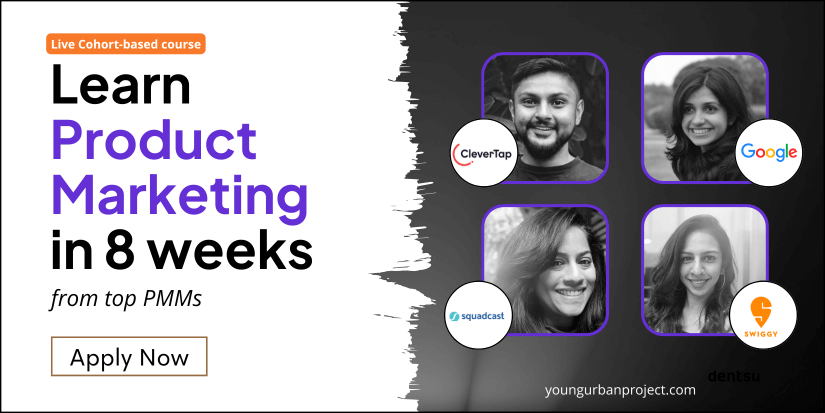
Checkout Our 8-Week Product Marketing Training
7. Leverage Public Relations (PR)
Public relations help build a strong and trustworthy brand image. Press releases, news articles, interviews, and social media mentions make your brand look credible. Collaborating with journalists or industry influencers can increase your reach. A good PR strategy ensures that your business gets positive attention and stands out from competitors. PR efforts can also help during crises, protecting your brand’s reputation.
8. Implement Sales Promotions
Sales promotions encourage people to buy now rather than later. Limited-time offers, discounts, loyalty programs, and bundle deals create urgency. For example, “Buy one, get one free” or “50% off for the next 24 hours” makes customers feel they must act fast. These promotions also keep existing customers engaged, making them more likely to return.
9. Explore Direct Marketing Strategies
Direct marketing allows you to communicate with customers one-on-one. Email newsletters, text messages, personalized offers, and direct mail campaigns can make customers feel special. When customers receive a message that directly speaks to their needs, they are more likely to engage. Direct marketing also helps businesses build strong relationships with loyal customers, increasing long-term sales.
Factors Affecting Promotion Mix
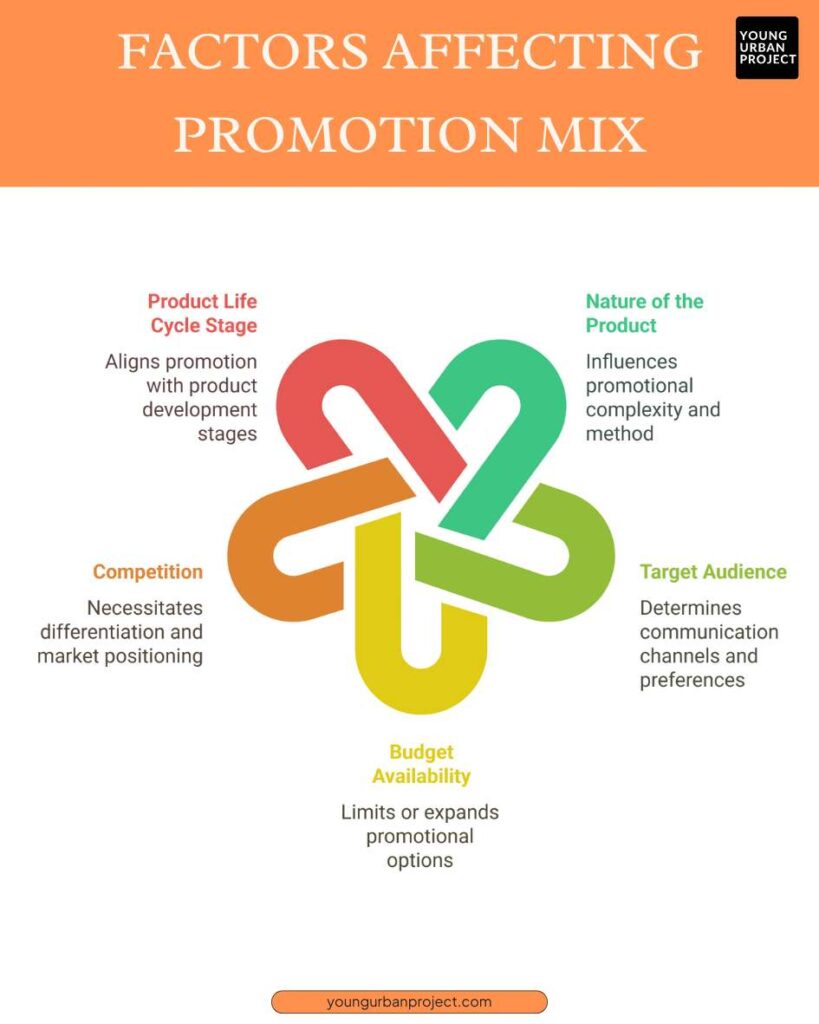
1. Nature of the Product
The type of product you sell affects how you promote it. Some products need more explanation, while others sell quickly with simple ads. For example, a luxury car requires detailed marketing, test drives, and personal selling, while a candy bar can sell with just a catchy ad. Physical products often need in-store promotions, while digital products may rely more on online marketing. The price, uniqueness, and complexity of the product all influence the promotion strategy.
2. Target Audience
Knowing your audience is key to effective promotion. Different people prefer different ways of communication. Younger customers may engage more with social media ads and influencers, while older customers may respond better to TV commercials, newspapers, or emails. Businesses selling to professionals may use LinkedIn and email marketing, while companies targeting teenagers may focus on Instagram and TikTok. Understanding audience preferences helps in choosing the right promotional methods.
3. Budget Availability
It costs money to promote a business, so businesses must plan their promotion budget. Small businesses with low budgets might put their promotional eggs in the social media and word-of-mouth baskets. In contrast, larger businesses can afford to promote via the much more expensive channels of TV ads, billboards, and singing stars. How far and how wide a business can push its name and brand depends largely on how much it can spend. Even with limited funds, businesses can still market effectively by choosing cost-efficient strategies and tactics.
4. Competition
The number of competitors in the market affects how aggressively a business needs to promote. If many companies sell similar products, strong marketing is needed to stand out. Businesses may offer discounts, special promotions, or influencer collaborations to attract customers. If there are few competitors, promotion may focus more on building brand awareness and educating customers about the product. Watching competitor strategies helps businesses adjust their own promotions to stay ahead.
5. Stage in the Product Life Cycle
A product goes through different stages in a product life cycle: introduction, growth, maturity, and decline. Each stage requires a different promotional approach. In the introduction stage, businesses need heavy promotion to create awareness, using ads, influencers, and public relations. During growth, companies focus on increasing sales with social proof, testimonials, and customer engagement. In maturity, competition is high, so businesses use loyalty programs, special offers, and rebranding to maintain interest. In the decline stage, promotions may focus on clearance sales or repositioning the product for a new market.
Also read: What is a Product Line?
Promotional Mix Examples
1. Amul: Topical Advertising & Public Relations
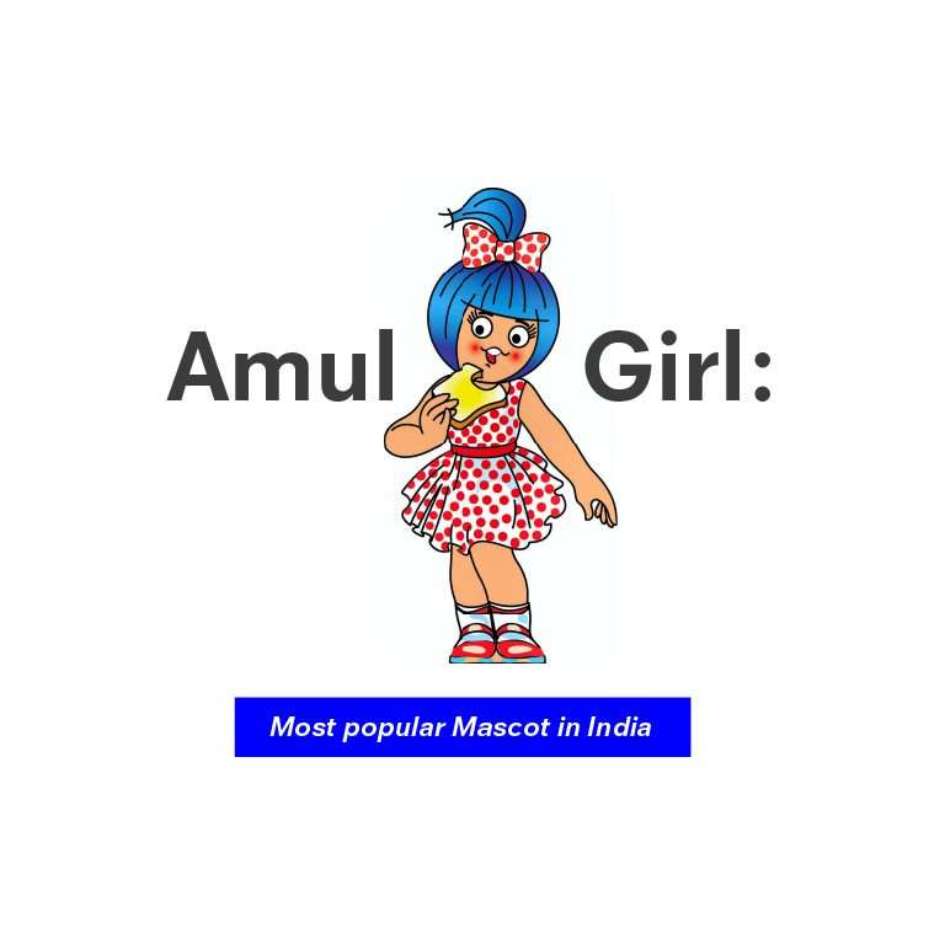
Promotional Strategies Used:
✔ Advertising (Print, Digital, Outdoor) – Amul’s utterly butterly campaigns have been iconic for decades. Their witty, topical advertisements featuring the Amul Girl provide social commentary while subtly promoting their products.
✔ Public Relations (PR) – Amul maintains a strong brand presence by engaging in CSR activities, farmer welfare programs, and sustainable dairy production.
✔ Social Media Marketing – Amul actively posts their ads on digital platforms like Twitter, Facebook, and Instagram, keeping up with trends.
Example:
- During major events like elections, cricket tournaments, or Bollywood releases, Amul releases creative ads that instantly connect with the audience.
- Their 2020 ad on social distancing featuring “Utterly Safe” messaging was widely shared.
2. Fevicol: Humorous & Relatable Advertising

Promotional Strategies Used:
✔ Creative Advertising (TV, Print, Digital, Outdoor) – Fevicol’s humorous and memorable ads focus on the product’s unbeatable strength.
✔ Social Media Engagement – The brand actively shares old and new campaigns to keep the audience engaged.
✔ Event Sponsorships & PR – Fevicol often sponsors carpentry and furniture expos, reinforcing its position as the most trusted adhesive.
Example:
- Fevicol’s famous “Fevicol Bus Ad” showed passengers stuck to the roof of a crowded bus—demonstrating the adhesive’s unbreakable bond in a hilarious way.
- Their “Fevicol Sofa Ad,” where generations of a family sit on the same sturdy sofa for decades, became an all-time classic.
Also read: What is Product Mix?
3. Thums Up: Celebrity Endorsements & Adventure Branding
Promotional Strategies Used:
✔ Celebrity Endorsements (Advertising & PR) – Thums Up is endorsed by Bollywood stars like Salman Khan, Mahesh Babu, and Ranveer Singh, reinforcing its macho image.
✔ Sponsorship & Sports Marketing – The brand collaborates with cricket events, adventure sports, and stunt-based ads.
✔ Digital & Social Media Campaigns – Campaigns like #ToofaniTaste emphasize the brand’s bold personality.
Example:
- The “Aaj Kuch Toofani Karte Hain” campaign, featuring daring stunts and action-packed sequences, appeals to adventure seekers and reinforces its ‘bold’ brand image.
- During the 2021 Tokyo Olympics, Thums Up ran a campaign celebrating Indian athletes, boosting brand credibility.
4. Havmor Ice Cream: Experiential & Digital Marketing
Promotional Strategies Used:
✔ Experiential Marketing (Interactive Consumer Engagements) – Havmor launched “The Coolest Summer Job,” where consumers could create their own ice cream flavors.
✔ Influencer & Social Media Marketing – The brand collaborates with food bloggers and influencers to showcase its unique flavors.
✔ Festive Campaigns & Seasonal Offers – Special promotions during Diwali, Holi, and summer help boost sales.
Example:
- “The Coolest Summer Job” campaign let selected participants design a new ice cream flavor, resulting in increased engagement and brand love.
- Their Winter Ice Cream campaign broke the stereotype that ice cream is only for summer, leading to year-round sales.
5. Zomato: Digital Marketing & Viral Social Media Strategies
Promotional Strategies Used:
✔ Social Media Marketing (Humor & Memes) – Zomato’s witty Twitter posts and meme-based marketing make it one of the most engaging brands online.
✔ Push Notifications & Email Marketing – Their clever, humorous push notifications ensure customers keep coming back to the app.
✔ Influencer & Referral Marketing – They use influencers and referral programs to drive app downloads and customer retention.
✔ Discount-Based Promotions & Partnerships – Zomato Gold and Pro memberships offer exclusive discounts, encouraging repeat orders.
Example:
- Zomato’s “Kabhi Kabhi Ghar Ka Khana Bhi Achha Lagta Hai” tweet went viral, showing their smart, conversational marketing mix approach.
- They capitalize on food trends (e.g., trending dishes, IPL food offers) to boost engagement.
Also read: Types of Marketing to Promote Your Brand
Conclusion💭
A marketing strategy absolutely requires a well-thought-out promotional mix. The mix may contain various tool components, such as advertising or PR. Other components might focus primarily on the personal side of the business, such as selling to customers or engaging with them on digital platforms. Whatever the case, the promotional mix must reflect the business and its values. Otherwise, a business might as well be mixing oil and water.
To implement a promotional mix effectively, begin by identifying your target audience. Next, define clear goals and allocate a budget. Select the right channels to communicate with your audience; then craft messages that will resonate and elicit a response. Use ads, public relations, and sales promotions as part of the mix. Finally, consider direct marketing and digital Marketing tools, like social media, to reach your target demographic.
A strategic promotional mix that achieves growth and a competitive edge in the modern marketplace must consider several dimensions, chief among them: product, audience, budget, and competition. By achieving a balance among these crucial factors, businesses of all sizes can put together a proto-strategy that, in many cases, can be said to deliver measurable results. To the extent that such a scenario unfolds, it can be said that a strategic promotional mix is in place, with “mix” here implying balance and harmony among the several dimensions discussed.
💡FAQs: What is Promotion Mix?
1. What does the term “promotion mix” mean?
A promotion mix is a combination of tools used to promote a product or service. It includes advertising, PR, personal selling, direct marketing, and digital marketing. These tools work together to reach customers, build brand awareness, and increase sales. It’s a key part of any marketing strategy.
2. How does publicity fit into the promotion mix?
Publicity is part of public relations (PR) in the promotion mix. It involves getting free media coverage to promote a product or brand. Unlike ads, publicity is not paid for. It helps build trust and credibility by sharing news or stories about the brand through third-party sources like news outlets or social media.
3. What are the key components of a promotion mix?
The promotion mix includes advertising, public relations, personal selling, direct marketing, and digital marketing. Advertising uses paid channels like TV or online ads. PR builds a positive image. Personal selling involves direct interaction. Direct marketing targets specific customers. Digital marketing uses online platforms. Together, they help promote products effectively.
4. What factors impact the promotion mix strategy?
The promotion mix is influenced by factors like the type of product, target audience, budget, competition, and the product’s life cycle stage. For example, a new product Launch may need more advertising, while a mature product might focus on sales promotions. Understanding these factors helps create the right mix for success.
5. Why is the promotion mix essential in marketing?
The promotion mix is important because it helps create brand awareness, engage customers, and boost sales. It allows businesses to stand out from competitors and build customer loyalty. By using the right mix of tools, businesses can effectively communicate their message and achieve their marketing goals.

